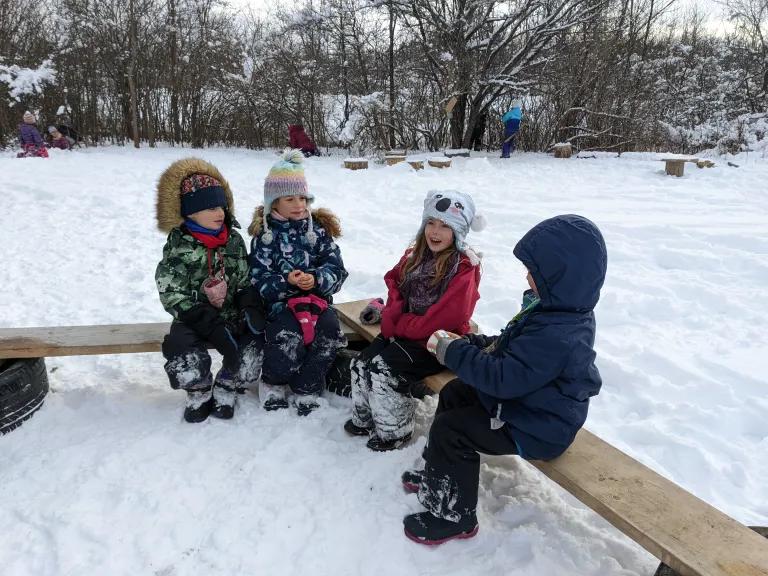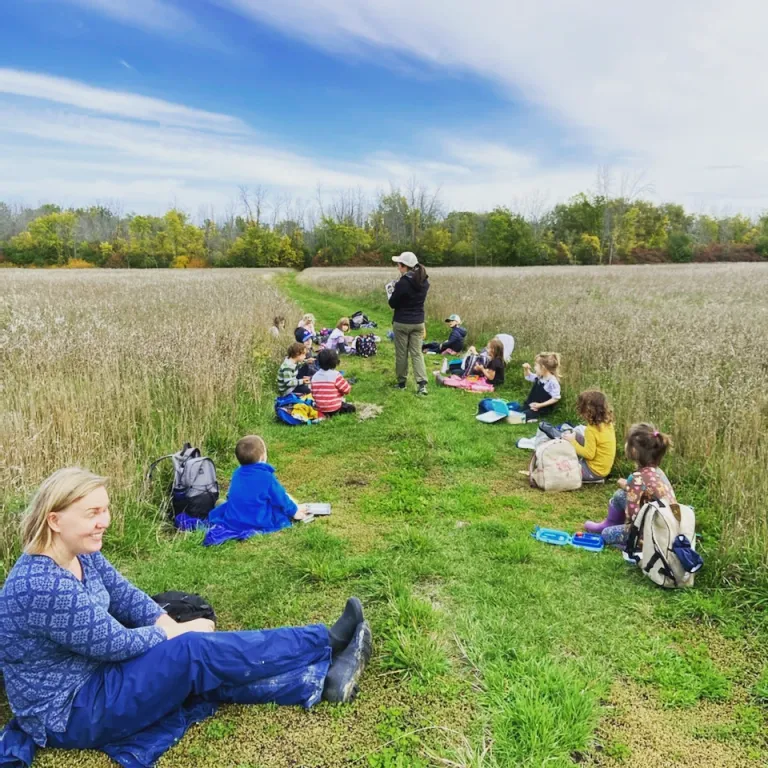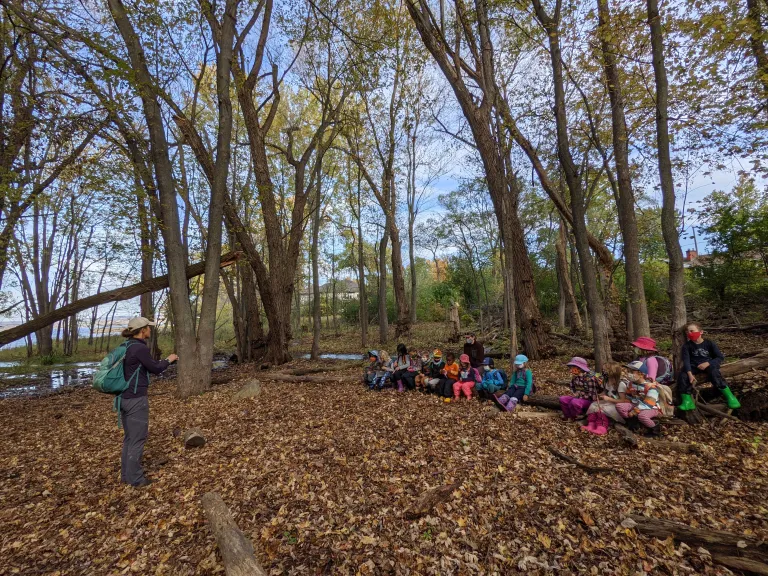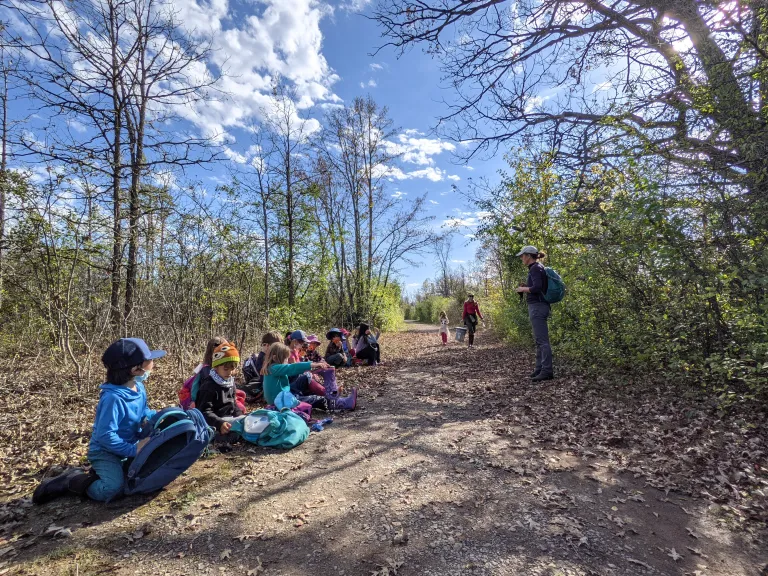Stories swirl around us all of the time- our own, those of our neighbours and friends, Stories from the land, the creatures, the weather. As long as we are ready to listen, the Stories come, and with them are often timely, meaningful lessons, too.
I was recently remembering the process I’ve gone through in getting comfortable telling Stories off the top of my head. This led to remembering different ways that I’ve shared ideas and provocations that have mixed things up as well as supported the children in their own storytelling practices, too.
Maybe one of these ideas will resonate with you and you’ll feel like trying it with the children in your care.

1. Ask for input from listeners.
It can be as simple as asking a question. You can provide provocations like “I think I feel a colourful Story swirling around us. Think about the colours you see when the sun goes down (or when there’s a rainbow or when you’re walking around at the park). What colours do you notice? Who can give me an example of something that is red? Yellow? Green? Some other colour?” Then tell a Story that include those colours.
Or “I can feel a Story waiting to be told. My skin is tingling just thinking about it. I need some help. Who can name a smooth object you might find in the forest or at the beach? Who can name something bumpy? Something flat? Something heavy? Something fuzzy? Something pointy? Something soft? Thank you! The Story is ready to join us now.”
Or simply “What sorts of creatures do you think wander through this park at night?”. Get the list, and make them the main characters in your Story.

2. Pull words out of a bag.
I can show up with the words already in the bag or I can get ideas from the group, or maybe I already had one or two friends help me with that part. Then I or we, depending on the dynamic of the group, pull 3-5 words out of the bag and tell the Story.
Butterfly-Moon-Mountain- that’ll make a great Story.
Tall Tree-Giant Puddle-Bumblebee-Magic- yup, that will too.
You can do it over and over again and always get different ideas.
(Another way this works is to take turns- I pull a word and start the Story, a child pulls a word out and adds to it, and we carry on like that. This can work with partners or small groups.)
3. Pull items out of a bag.

This can be a fun way to start the day with the sparking of the group’s imaginations, pulling items out of the bag at special moments in the story, such as “…and when Chickadee moved the snow away with her wing she found a… Very… Smooth…Rock,” which I then pull out of the bag. I might hold it up to clearly show everyone, or I might pass it around. The items can be quite common and easy to find on a schoolyard, and that doesn’t make them any less magical in a Story at all. Indeed, I’ve arrived at a school before, realized I had forgotten my bag of Story Seeds, so spent 2 minutes gathering some pine needles, a pine cone, a ball of snow, and a few different shaped rocks from the little garden out front. I shoved them into my jacket pocket and was ready to go!
4. Ask listeners to bring a natural found item to circle.
I’ve used this one most often with adults, and it works with children, too. When I hoot for everyone to come together before lunch or at the end of the day, I might ask them to all close their eyes and to take a deep breath and to listen. There is a natural object on the forest floor (seek out items that are no longer growing, please) that is calling to you. Please go find it and bring it back. It’s time to tell a Story. When everyone returns we can proceed in a couple of ways. I can gather the items and tell a Story with them. I can start the Story, modelling how to use my item, then offer children (or adults) the chance to add to it- they can give me their item to include or they can add to the Story in their own words. This one can get long and silly, and be so much fun! Folks may choose to hold onto their items, or I like to have us place them in the middle as they’re added- so we can all see them, so I can see who still has an item left as we go along, and so that we can see a physical manifestation of our Story creation when we are done.
5. Randomly select from a collection of photos.
It’s tough to put a mouse, the sky, or a frog into a bag to bring along (please don’t try!) and some friends, for various reasons, struggle with written English words, so another way to inspire the storytelling is to share photos and, as with the other ideas, either pull them out and tell the Story with photo support as you go, or ask the children to help with photo selection.
Listing these storytelling supports here has led to me remembering other simple provocations I’ve used, as well as variations of these ways. Like whether or not the items/photos/words need to enter the Story in the order they were selected or not. Or whether or not, once one group of words has been pulled out of the bag, they go back in for the next Story or not. These are simple changes that help to keep the process fun, interesting, and surprising.
We are all so filled with creativity- perhaps these ideas will help to nurture and form that into some storytelling fun for you at work or at home. Happy storytelling!!!


